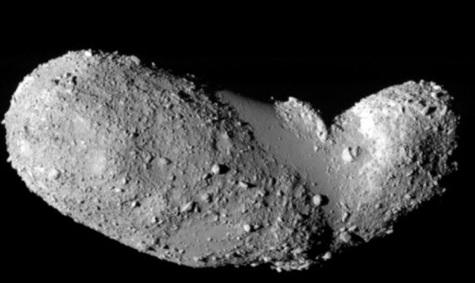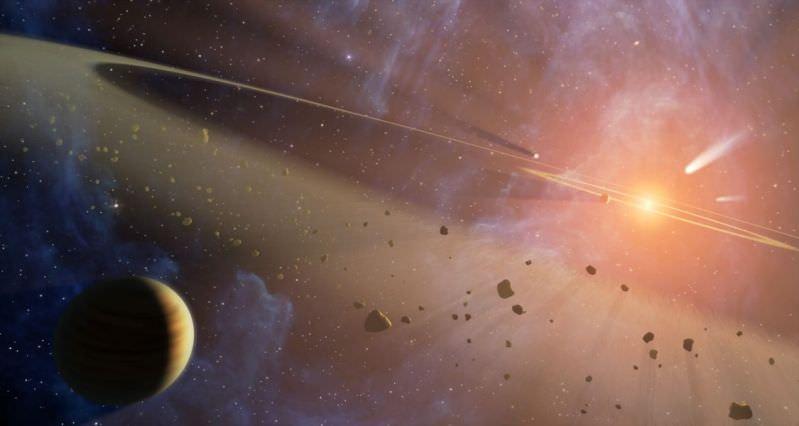M-type asteroids are the third most common type of asteroids in the solar system. Though they are “common,” we know very little about them.
Key Facts & Summary
- M-type asteroids are among the least studied asteroids in the solar system.
- Many asteroids in this class are made out of nickel-iron, either pure or mixed with small amounts of stone.
- All asteroids are rocky remnants from 4.6 billion years ago.
- Most M-type asteroids are moderately bright, having an albedo between 0.1 and 0.2
- The most massive known M-type asteroid is 16 Psyche, which has a diameter of 200 km / 120 mi. It is one of the ten most massive asteroids in the asteroid belt.
- 22 Kalliope is also a reasonably big M-type asteroid, having a diameter of 166 km / 103 mi. It was discovered in the same year as Psyche – 1852.
- Psyche is the only metallic core-like body discovered so far.
- Most M-type asteroids are located in the middle of the asteroid belt.
- The spectra of M-type asteroids are flat to reddish and usually devoid of significant features.
M-type asteroids are quite fascinating objects since we only partially know their composition. Some M-type asteroids have a completely uncertain composition, and only a few things about them have made them earn the M-type classification.

Most of these asteroids are located in the asteroid belt, more specifically in the inner region of the belt.
Formation
All asteroids are rocky remnants from 4.6 billion years ago. They are leftovers from the early solar system. Most of them are located in the central asteroid belt between Mars and Jupiter. The thickness of the asteroid belt is believed to be at around 1 AU.
They orbit the Sun, and among them, the M-type asteroids are the third most prominent. In the asteroid belt, there are several groups of different estimated ages. The Karin family, for example, is believed to have formed around 5.7 million years ago out of a single object. The Veritas family around 8.3 million years ago, and the Datura family at only 53.000 years ago.

Characteristics
Most M-type asteroids are moderately bright, having an albedo between 0.1 and 0.2. Some yet not all are made out of nickel-iron, either pure or mixed with small amounts of stone.
These materials are attributed to pieces of the metallic cores of differentiated asteroids that were fragmented by impacts and are thought to be the source of iron meteorites.

Their spectra are flat to reddish and usually devoid of significant features, although subtle absorption features long ward of 0.75 micrometers, and a short ward of 0.55 micrometers are sometimes present.
Some M-type asteroids have an uncertain composition or certain inconsistencies.
Examples of M-type Asteroids
The 22 Kalliope M-type asteroid is a particularly exciting object. It has an accurately known density that is far too low for a solid metallic object or even a metal rubble pile.

A rubble pile of iron-nickel metal would need about 70% porosity, which is inconsistent with packing considerations. Both 22 Kalliope and 21 Lutetia have certain features in their spectra, which appears to indicate the presence of hydration minerals and silicates, anomalously low radar albedos inconsistent with a metallic surface, as well as characteristics more commonly found in C-type asteroids.
Many M-type asteroids do not fit well into a metallic body picture.
The most massive known M-type asteroid is 16 Psyche, which has a diameter of 200 km / 120 mi. It is one of the ten most massive asteroids in the asteroid belt. Its mass represents 1% of the asteroid belt’s mass.
Specific characteristics lead scientists to believe that 16 Psyche is the exposed iron core of a former protoplanet. This giant was discovered in 1852 by the Italian astronomer Annibale de Gasparis.

The prefix “16” indicates that it was the sixteenth minor planet in order of discovery. The asteroid has a dense and mostly metallic composition, which is consistent with its high albedo is one of the brightest in the asteroid belt.
Psyche is not part of any known family of asteroids, even though it appears to be a part of a larger body. It is the only metallic core-like body discovered so far.
22 Kalliope is also a reasonably big M-type asteroid, having a diameter of 166 km / 103 mi. It was discovered in the same year as Psyche but by a different astronomer J.R. Hind.
Kalliope is slightly asymmetric, and its surface is partially composed of iron-nickel metal. Its density has been calculated to be at 3.4 g/cm3, and since it is most likely to be a rubble pile, the material density could reach 4.2 – 5.8 g/cm3, which means that Kalliope is most likely made of a mixture of metal with silicates.

Kalliope also has its own satellite, Linus, and it is quite large, having a diameter of 28 km / 17.3 mi. The satellite was discovered in 2001.
Location
Most M-type asteroids are located in the middle of the asteroid belt. There are millions of asteroids more than 1 km / 0.5 mi across in the asteroid belt. The smallest asteroids are even more minuscule than this; however, their sheer numbers are far greater than the larger ones.
The distance between the asteroids in the belt has been calculated to be at around 600.000 mi / 1 million km. A spacecraft would easily navigate in the belt without too much risk.

The Future
Though M-type asteroids are the third most numerous and have survived for millions of years, one day, the entire asteroid belt will be gone. This will happen when the Sun approaches the end of its life. The Sun’s powerful last light will shatter the asteroids with radiation, and perhaps nothing will remain of them.
Did you know?
- The first M-type asteroid to be imaged by a spacecraft is 21 Lutetia, an asteroid with a diameter of 100 km / 62 mi.
- The M-type asteroid 216 Kleopatra was imaged by radar, and it appears to have a dog bone-like shape.
- The initial “M” stands for metallic, though, as it was displayed, many asteroids of this class can lack this feature.
- If you stood on an asteroid in the asteroid belt, you wouldn’t be able to see the other asteroids due to their size and overall distance.
- Some believe that the asteroid belt is merely the remnants of a destroyed planet. However, the calculated remaining mass is not enough to support this.
Sources:
Image sources:
- https://www.astronomysource.com/wp-content/uploads/2012/08/itokawa06_hayabusa.jpg
- https://www.universetoday.com/wp-content/uploads/2009/10/icy-asteroid.jpg
- https://upload.wikimedia.org/wikipedia/commons/thumb/6/63/Motif_de_%22Widmanst%C3%A4tten%22_%C2%A9dada_677.jpg/330px-Motif_de_%22Widmanst%C3%A4tten%22_%C2%A9dada_677.jpg
- https://upload.wikimedia.org/wikipedia/commons/thumb/1/17/Rosetta_triumphs_at_asteroid_Lutetia.jpg/486px-Rosetta_triumphs_at_asteroid_Lutetia.jpg
- https://nineplanets.org/wp-content/uploads/2019/09/asteroid-belt.png
- https://www.astronomysource.com/wp-content/uploads/2012/08/Asteroid-capture1.jpg
- https://resize.hswstatic.com/u_0/w_480/gif/asteroid-belt-1.jpg
